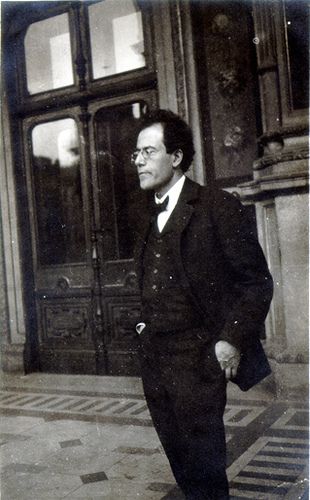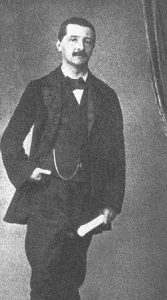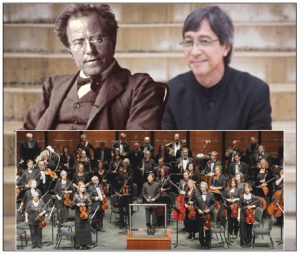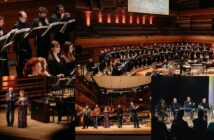MAHLER: Symphony No. 6. Austin Symphony Orchestra/Peter Bay, conductor. Long Center for the Performing Arts, Austin, Texas. March 25, 2017
Symphony No. 6 first saw the light of day in 1906 when Mahler himself conducted its premiere performance in Essen, Germany. Not well received, it was rarely performed again during his lifetime. Concert goers in the United States had to wait forty-one years (1947) after its premiere to hear it, and to this day performances of the Mahler 6th continue to be fairly rare.

Gustav Mahler at the Vienna Court Opera 1903
To be sure, there are plenty of recordings of Mahler’s 6th Symphony, but live performances are problematic for a variety of reasons: the 6th is expensive to produce; it requires an orchestra of at least 95-100 players – more is even better, especially in the strings; it requires a good deal of rehearsal time, and it is so long (80 minutes with no intermission) that it restricts programming. This presents orchestra managers with a dilemma, as it leaves no room on the program for a concerto with a big-name soloist to draw in the crowds. While Mahler’s name is not the box-office poison it used to be, many music-lovers still find much of his music – especially the longer symphonies – difficult to digest.
Peter Bay is in his 18th season as music director and conductor of the Austin Symphony (ASO) and in that time he has conducted five of the nine (ten if you include the unfinished Symphony No. 10) Mahler symphonies. At this rate, he will probably need another 15 seasons to get through them all. This is really not good enough. Many of the Mahler symphonies are now standard repertoire for nearly all professional orchestras and the communities in which they work are surely entitled to hear them. Not only are orchestras all over the world programming Mahler symphonies every season, many of them often present Mahler cycles, doing all the symphonies in one season or in two or three consecutive seasons.
The Austin Symphony finally got around to the Mahler 6th this season, but for the 2017-2018 season they have programmed only the Britten reduced orchestra arrangement of a movement from the Mahler Third Symphony. The Board and management of the ASO really need to do better, especially since the orchestra has demonstrated that not only can it play this music with the best of them, but also that in Peter Bay they have a conductor with a genuine affinity for Mahler’s music who can inspire his musicians to make the ASO’s Mahler performances truly special events.

Shades of Bruckner
I recently attended a performance of Bruckner’s Symphony No. 1 in Houston and I was reminded that the opening of this work is very similar to the beginning of the Mahler 6th. In both cases, the tempo marking is ‘Allegro’ (Allegro energico, ma non troppo in the case of the Mahler, to be exact), and the music starts quietly with a march-like tread in the cellos and basses, starts to build with a short motivic idea and evolves into a louder full-blown theme. It is well-known that Mahler was influenced by Bruckner, and here the connection is particularly strong. Curiously, just a few score pages later in the Sixth Symphony, Mahler uses an actual quotation from Liszt’s Piano Concerto No. 1 in the trombone. Are these passages intended as explicit quotations on Mahler’s part? Perhaps, but they also make it clear that while Mahler broke new ground in his symphonies, he was also very much part of the great tradition of Austro-German romantic music.
Incidentally, while Mahler’s composition of the 6th Symphony was clearly influenced by the opening of Bruckner’s Symphony No. 1 and by many of Bruckner’s other stylistic features, he had great reservations about the quality of Bruckner’s music – especially in his Symphony No. 1:
After a superb beginning, a whole lot of confused and disordered nonsense, as clumsy from a contrapuntal as from a musical point of view, follows by way of development. At the end of this desert, the beautiful theme returns, followed anew by the most appalling of wildernesses. As for the grandiose conclusion, it bears no relation, either profound or superficial, to the rest.
Interestingly, although Mahler was one of the leading conductors of his time and knew Bruckner personally, he rarely conducted any of the Bruckner symphonies and when he did, he made major cuts in the scores.
Mahler’s Symphony No. 6 is a massive piece lasting about 80 minutes, and like so many Mahler works, it can be construed as a struggle between life and death. In some of these works, the struggle ends victoriously in one way or another. Symphony No. 2, for example, ends with a joyous affirmation of resurrection after death, and Symphony No. 4 with a delightful view of heaven through the eyes and ears of a child. Not so Symphony No. 6, which ends in complete catastrophe, perhaps a premonition by the composer of his own demise.
The final movement of the 6th Symphony includes three massive hammer blows, which some have taken to be a foreshadowing of terrible events about to befall the composer. Although in real life, he did indeed suffer a series of soul-destroying setbacks just a year later: the death of a child, loss of his job as head of the Vienna State Opera, and diagnosis of the heart disease that was soon to end his life, I personally don’t believe that Mahler – or anyone else, for that matter – could/can foretell his own future; it is enough that the hammer blows in the symphony relate to the life and death emotions expressed in the music itself.

The Hammer Blow Instrument

The Cowbells
The 6th Symphony calls for a very large percussion section, but even that was not enough for Mahler. He knew of no percussion instrument that would give him the effect that he wanted for the hammer blows, so he invented one. In the simplest terms, this was a large wooden box with a hammer – of no definite pitch, but massive and frightening – “like an axe stroke.” Such an instrument, if we can call it an “instrument”, does not exist in any definitive form in any orchestra in the world; hence, for Mahler 6th performances, orchestras have had to create their own versions of this “hammer box”, based on the composer’s description of the required sound. For the Austin performances, the ASO borrowed a “box and hammer” as well as the set of cowbells called for in the symphony, from the Dallas Symphony Orchestra.
In recent years, Austin has grown rapidly in geographical area and population. Sometimes compared to Silicon Valley for the number of IT companies which have moved here, it has also attracted thousands of individuals and families who want the wonderful quality of life that Austin has to offer. In those famous rankings of “Best Places To Live” and “Best Places To Retire”, Austin is invariably at or near the top of the list. Indeed, it is a great place to live.
Not surprisingly, as Austin has grown, so has its orchestra – in size and in quality – as more musicians have been attracted to the city. Audience numbers continue to grow, as do the donations that every orchestra needs to stay afloat.
The Mahler 6th was an excellent test of how far the ASO and its audience have come in recent years. I can report that for the two performances of Mahler 6th last week, there were few empty seats; Austin is ready for Mahler and lots of it.

Austin is ready for more Mahler.
I have already suggested that under the vibrant leadership of Peter Bay the orchestra played brilliantly. Listening to the ASO at this Mahler concert, there could be no doubt that the musicians rose to the challenge and met it with hours of practice at home and intense concentration in the full-orchestra rehearsals. The playing I heard was consistently inspired and – a necessity in Mahler – fearless. String players dug into the strings with passion and intensity, winds fashioned one beautiful phrase after another, brass played heroically, and percussion raised the rafters. It is impossible to single out individual players for their excellence, as this was an ensemble effort on the highest level. But even crack ensembles need leadership to excel. Peter Bay offered that leadership. He knew what he wanted in every bar and he had such a command of his forces that every tricky transition – and there are many in the Mahler 6th – was executed seamlessly.















